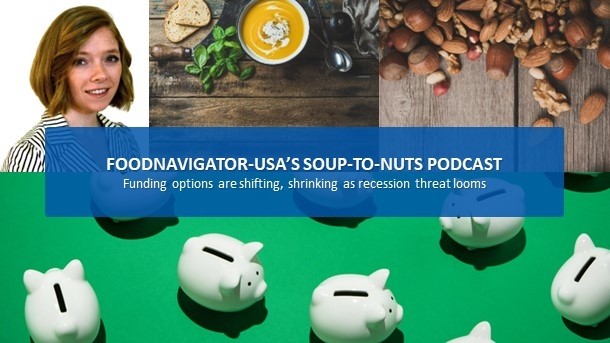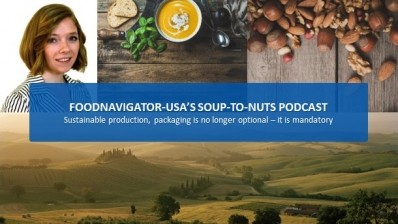Soup-To-Nuts podcast: Funding options shift, shrink as inflation rises, recession fears mount

Add to this the looming threat of a recession and fears that as consumers continue to dip into their savings that they may become resistant to additional price hikes and could shift their shopping habits by trading down or going without – making it unlikely that the financial taps will be thrown open again any time soon.
But, there are options, as we learn in this episode of FoodNavigator-USA’s Soup-To-Nuts podcast from eCapital Asset Based Lending CEO Jennifer Palmer. She explains how macro trends are impacting food and beverage businesses and their financial options, and how stakeholders on both sides of the table are rethinking their priorities and strategies in light of the challenges facing industry. As such, she also advises companies to act quickly to secure additional credit and financing because as the year goes on, this will become more difficult.
[Editor’s note: Never miss an episode of FoodNavigator-USA’s Soup-To-Nuts podcast – subscribe today.]
Investors are increasingly weary of evolving landscape
Since the pandemic began in March 2020, the food and beverage industry has been in a constant state of flux with new challenges cropping up often before old ones have been adequately addressed. And while many stakeholders have been fast on their feet and able to meet their obligations to both consumers and investors, Palmer warns that both may be nearing the end of their rope and rethinking their priorities.
“The landscape has shifted so quickly that it’s hard to even figure out where to begin. The food industry is being impacted simultaneously by so many issues, including inflation, higher costs to produce and ship goods, labor shortages, supply chain bottlenecks and at the same time you have rapidly changing consumer tastes and the ongoing pandemic,” Palmer said.
As companies quickly pivot to navigate these issues, investors “also are responding to these issues that are facing many CPG issues. Financiers and investors are getting nervous as we head toward the recession, and we need to tighten the leash. We’re analyzing companies performances more closely than ever and tightening up credit standards,” she said.
She added many teams are doing fewer deals than last year and valuations are coming down even in just the past few months so that both debt and equity is more expensive now.
“With the higher cost of capital, it’s important for companies who are navigating the supply chain issues to also think about their finances and use capital with even more discretion to navigate these changes,” Palmer advised.
A spending slowdown is nearing
In recent years, companies have leveraged several strategies to stretch their dollars in the face of inflation, including SKU rationalization, price-pack architecture, and price increases – most of which consumers have taken in stride.
But Palmer warns that consumers’ patience and wallets may be wearing thin, and that companies need to brace for an impending spending slowdown.
“The consumer is absolutely at its tipping point, and so companies need to control the burn, they need to stay on top of forecasts and model both upside and downside scenarios, and need to develop strategies for dealing with them,” she said.
She recommends companies reduce their volumes for Q2 and Q3, and brace for slower velocities. This may seem counterintuitive after years of uncertainty and the adoption during the pandemic of a ‘just in case’ inventory supply vs a ‘just in time’ approach from pre-pandemic.
But, Palmer said, inventory is like cash on shelf and companies need to be careful how much they are borrowing against it as consumer shopping habits shift again. Plus, she said, storage is increasingly expensive and must be factored in along side transportation expenses.
Check in with consumers
To effectively project realistic volumes with the threat of a recession on the horizon, Palmer encourages companies to check in with their consumers to see how their resources and priorities might be evolving and then reframe their value proposition accordingly.
For companies that do this effectively, Palmer says there is still plenty of capital available, but she adds they need to act fast.
What are lenders looking for?
As competition for funding heats up, Palmer says financers will place a premium on companies that are stable, have experienced management, strong margins, built in redundancies for supply security and can reliably forecast their needs and performance.
Beyond that, Palmer said she looks for management teams with open, honest communication styles, who can effectively forecast and have all their bases covered not just once but sometimes two or three times.
The numbers also matter – especially margins, which Palmer says most financial teams know are compressed currently, but which they also want to see moving north. While margins vary by category, anything below 30% is a red flag, she added.
Lenders give ESG more credence
How companies do business is just as important as the results they see, according to Palmer who said that contrary to expectations ESG expectations during the pandemic didn’t dwindle, but rather gained importance.
“We all probably thought ESG would be stalled during the pandemic, but we actually saw efforts accelerate during that period of time, and obviously CPG companies have been awarded for EGS efforts driven by conscious buyers,” she said.
Institutional banks are also committed to ESG effort today, she said adding, “for companies that are in the ESG space, it’s a really exciting time, because lenders are aggressively seeking out these companies.”
Lenders also increasingly are interested in companies with domestic and in-house production, and making money available to those that want to move in this direction as a way to hedge against supply chain and transportation challenges that plague the industry.
Consider alternative funding, additional credit now
As the landscape continues to shift, Palmer urges companies that need – or think they might want – additional funding flexibilities in the coming years to act quickly and to look beyond banks and equity sources.
“Look at alternative sources of capital out there and … if you have the capital already, see if you can get access to more or if you can increase your line of credit or get greater flexibility. Now’s the time – you don’t want to wait much longer,” she advised.
To secure this, she noted companies will need a solid financial team in place, including a controller or CFO depending on the size of the company.
She also advised companies look for lenders that will offer more than capital to ensure long term success, including advice and a helping hand in unexpected situations.










